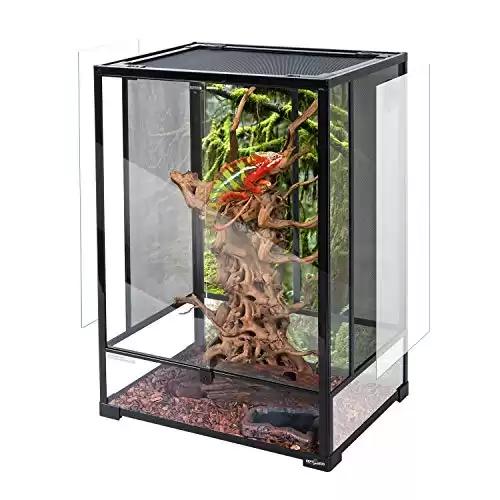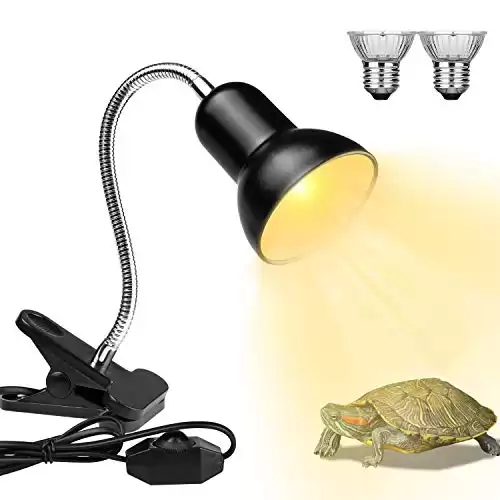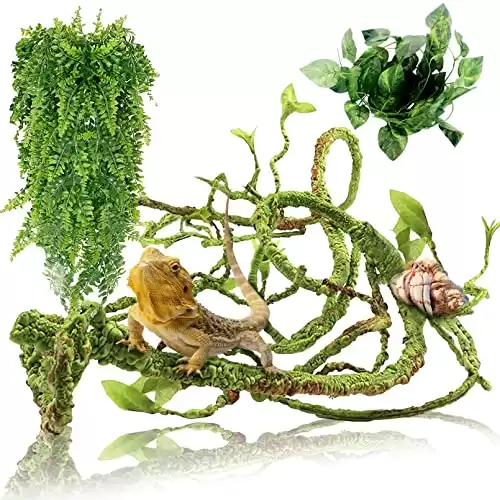Jackson’s chameleons are probably my favourite looking chameleon.
Native to the lush forests of East Africa, these three-horned chameleons are like the undercover agents of the reptile world. They may be pint-sized, but their yellow-crested, horned heads and vibrant green bodies make them stand out in a crowd.
In this guide, I’ll spill the beans on everything you need to know about these fascinating creatures – from their sneaky color displays to their love for playing hide-and-seek in the treetops.
Let’s get to learning!
How Do Jackson’s Chameleons Look?
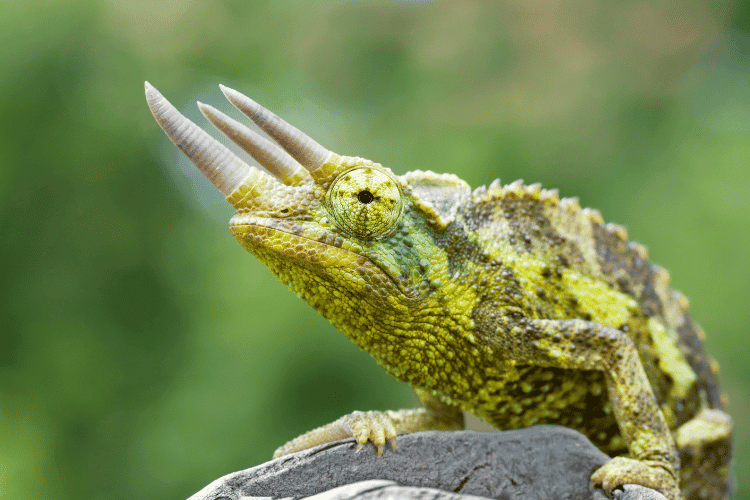
Jackson’s chameleons, scientifically known as Trioceros jacksonii, are distinctive reptiles native to East Africa.
Notably, males of this species display a striking emerald green coloration with blue and yellow facial and foot markings. In contrast, females exhibit more subdued coloring.
The defining characteristic distinguishing males from females is the presence of three prominent horns on the male’s head.
These horns serve a territorial purpose, akin to the function of the triceratops dinosaur. Even among horned animals, such as rhinoceroses, having three horns is rare; most have one or two.
In terms of size, Jackson’s chameleons are relatively small, with an average weight of up to 150 grams or 5oz, equivalent to that of a baseball. They typically measure between 9 to 13 inches or 25-35 cm in length, with males generally being larger than females.
The yellow-crested Jackson’s chameleon, a specific variant, can reach lengths of up to 15 inches. Conversely, the dwarf Jackson’s chameleon is much smaller.
Belonging to the Chamaeleonidae family within the Reptilia class, Jackson’s chameleons are divided into three subspecies: the Jackson’s chameleon, the Dwarf Jackson’s chameleon, and the Yellow-crested Jackson’s chameleon.
The genus name “Trioceros” is derived from the Greek words “tri-” meaning three, and “kéras” meaning horns, aptly describing one of their most prominent features.
Where Do Jackson’s Chameleons Live?
Our chameleons have established their habitat in the mountainous regions of East Africa, specifically in Tanzania and Kenya.
These reptiles have adapted to life in the lush mountainous landscapes, creating a unique niche for themselves within these environments.
Found primarily in the treetops, Jackson’s chameleons are the arboreal residents of the animal kingdom.
Their preference for elevated habitats is closely linked to the advantages provided by the mountainous rainforests. Here, they find a combination of shelter and sustenance.
As skilled hunters, they rely on the abundant insect life found in these forests for their diet.
Jacksons chameleons like a temperate climate, with good humidity. They thrive in mild daytime temperatures, which offer ideal conditions for basking in the dappled sunlight that filters through the forest canopy.
However, as night falls, they seek shelter due to the drop in nighttime temperatures, which can be quite extreme in the mountains. Maintaining their body temperature within an optimal range is crucial for their well-being.
What Is the Ideal Captive Habitat for Jackson’s Chameleons?
Let’s explore how to create the ideal tank setup for your Jackson’s Chameleon and the equipment you will need.
Equipment Needed for Jackson’s Chameleon
- A Vertical Enclosure
- UVB Lighting
- Heat Source
- Thermometers/Hygrometers
- Substrate (paper towels or newspaper)
- Branches/Plants
- Misting System
- Water Source
- Feeding Supplies
- Calcium Supplements
- Perches
- Cage Cleaning Supplies
Ideal Tank
Newborn and juvenile Jackson’s chameleons should be housed in an enclosure measuring 16″ x 16″ x 30″ until they reach approximately 10-12 months of age.
For adult Jackson’s chameleons, a minimum enclosure size of 18″ x 18″ x 36″ is recommended. Providing more space, such as 24″ x 24″ x 48″, is a better choice for long-term housing.
These chameleons require ample airflow as well, making mesh or screen enclosures preferable to traditional glass or plastic ones used for other reptile species.
Light and Heat
Your chameleon will also need full-spectrum UVA or UVB lighting for their well-being. These lights help with vitamin D production, which is essential to prevent metabolic bone disease and support their nervous system, bone, and muscle health.
Remember too, that these chameleons are most active during the day, so it’s recommended to set the UV light on a timer for 10 to 12 hours to mimic daylight hours.
Additionally, maintain a daytime temperature between 70-80°F (21-27°C) with a designated basking area not exceeding 85°F (30°C).
Ceramic heating elements and basking lights or heat pads can help the enclosure to get to these temperature ranges accurately. Also you will need shade and cooling spots within the enclosure, so the chameleon can relax in the cool.
For nighttime, set the temperature to 60°F, either using your home’s natural temperature or by adjusting heating elements as needed.
Further, this species of chameleons thrive in high daytime humidity (up to 100%) and nighttime humidity around 30%. Use digital hygrometers on both sides of the enclosure to monitor humidity levels.
Substrate and Decor
As for the substrate type, since your chameleon will spend most of its time above ground, a substrate isn’t necessary. You can use paper towels, newspaper, or opt for no substrate at all to prevent ingestion risks. Avoid materials that chameleons might mistake for food though, such as wood chips.
No need for heavy enclosure decor either as they don’t require fake rocks or caves. Instead, fill the space with branches and plants (real or fake). Non-toxic live plants, like Ficus, are suitable choices.
What Are the Ideal Tank Mates for Jackson’s Chameleons?
Your Jackson chameleon is renowned for its solitary lifestyle, and this solitary nature should be respected in captivity.
These reptiles thrive when housed alone in their dedicated enclosure. Attempting to introduce them to other reptiles or animals is not advisable, as it can lead to stress, aggression, and potential harm.
Chameleons, including Jackson’s chameleons, are territorial creatures. Placing them in close proximity to other chameleons or different species can disrupt their well-being and comfort.
What Are the Feeding Habits of Jackson’s Chameleons?
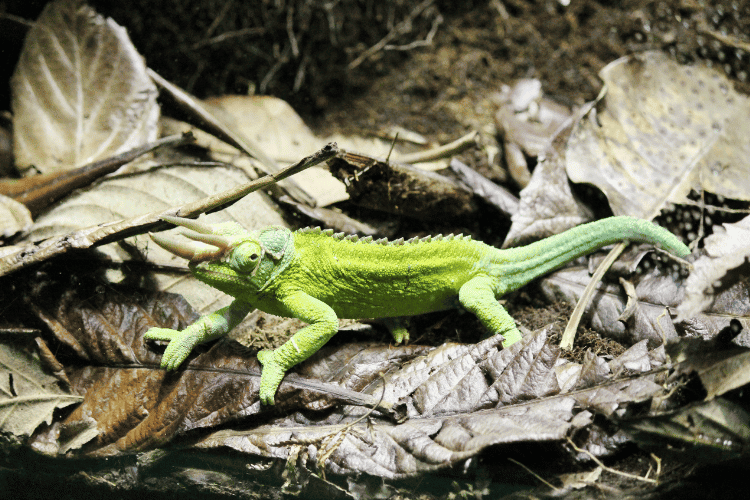
Jackson’s chameleons, like their chameleon relatives, are insectivores at heart. Their diet primarily consists of a diverse array of live insects.
In their native habitat of East Africa, these chameleons demonstrate a remarkable ability to consume various small insects, including crickets, mealworms, spiders, flies, moths, and other invertebrates.
Their specialized feeding technique involves the use of their long, sticky tongues. With lightning-fast precision, they extend their tongues to capture insects from a distance, enabling them to catch prey that might otherwise elude them due to their slow movements.
While these vibrant chameleons may consume a small amount of vegetation, live bugs remain the core of their nutrition.
To promote the health and well-being of your pet, it’s essential to provide a varied diet of gut-loaded insects.
Gut-loading involves feeding the insects a nutritious diet before offering them to your chameleon. This process ensures that the chameleon receives vital vitamins and minerals through its prey, contributing to their overall nutritional needs.
What Is the Temperament of Jackson’s Chameleons?
These colorful chameleons possess a unique temperament, with individual variations in behavior.
In general, they are known for their relatively docile and laid-back disposition compared to some other chameleon species. However, it’s essential to understand that they do not exhibit the same level of friendliness or sociability as other reptiles such as Leopard Geckos.
Typically, Jackson’s chameleons tend to be more even-tempered as they mature. Some individuals may become tolerant of human presence with cautious and minimal handling.
Nevertheless, they are not naturally inclined to seek interaction with humans, and excessive handling or stress can have adverse effects on their well-being.
When these chameleons feel threatened or stressed, they may display defensive or aggressive behaviors, such as hissing, puffing up, or even biting.
To minimize stress and ensure their overall well-being, it’s advisable to maintain minimal handling and provide them with a suitable habitat where they can be observed from a distance without frequent interactions. This approach is essential for their comfort and temperament.
What Are the Common Health Issues for Jackson’s Chameleons?
Jackson’s chameleons, like many reptiles, are susceptible to several health issues that can impact their well-being. It’s crucial for their owners to be aware of these concerns, understand the signs of illness, and practice preventive care.
Additionally, a veterinarian specializing in reptile care can provide guidance on preventive care practices and promptly address any health concerns that may arise. Aim for check-ups every 6-12 months to ensure your chameleon’s well-being and longevity.
That said, here are some common health issues:
Metabolic Bone Disease (MBD)
MBD is a prevalent problem in chameleons, including Jackson’s chameleons. It arises from a deficiency in
To prevent MBD, provide appropriate
Respiratory Infections
All chameleons are susceptible to respiratory infections. These infections can develop due to improper humidity levels, low temperatures, or unsanitary living conditions.
Signs of a respiratory infection include wheezing, nasal discharge, and labored breathing. Maintaining suitable habitat conditions and cleanliness can help prevent respiratory issues.
Gastrointestinal Disease
Gastrointestinal problems, such as diarrhea or constipation, can affect chameleons. Keep an eye out for symptoms like runny or bloody stools, weight loss, or a loss of appetite.
Optimal nutrition, including a balanced diet and clean water supply, can help mitigate gastrointestinal concerns.
Dehydration
Any chameleon requires adequate hydration. Dehydration can occur if they lack access to clean water or if humidity levels in their habitat are too low.
Symptoms of dehydration include sunken eyes and dark coloration. Ensure a consistent source of clean water and maintain appropriate humidity levels.
Eye Infections
Excessive heat or humidity can contribute to eye infections in Jackson’s chameleons. These infections may manifest as eye discharge, swelling, or difficulty closing the eyelids.
Proper habitat conditions, including maintaining suitable temperature and humidity levels, can reduce the risk of eye infections.
What Is the Lifespan and Size of Jackson’s Chameleons?
Neonates, which are newly hatched or born chameleons, usually measure around 3 to 5 inches (7.6 to 12.7 cm) from nose to vent.
As they mature, they undergo gradual growth, reaching their adult length by around 8 months old. At this stage, females generally measure between 8 to 12 inches (20 to 30cm), including their tails, while males can range from 9 to 13 inches.
When they reach adulthood, these chameleons typically range from 7 to 14 inches (18 to 36 cm) in total length. Males tend to be larger, with some individuals reaching impressive lengths of up to 14 inches.
As for the lifespan of these chameleons, it varies depending on factors such as gender and the quality of care they receive.
In captivity, healthy male Jackson’s chameleons can live impressively long lives, spanning from 8 to 10 years. In contrast, females have a somewhat shorter lifespan, typically ranging from 4 to 5 years.
What Are the Breeding Habits of Jackson’s Chameleons?
Unlike most chameleons, Jackson’s chameleons are viviparous, meaning they give birth to live young rather than laying eggs. The female carries her offspring inside her body during a process known as gestation.
The gestation period for Jackson’s chameleons is approximately 190 days. This extended period means that the female remains pregnant for a significant portion of the year.
That said, mating typically takes place during the summer months. The male initiates the mating ritual, which involves a display that includes color changes, throat inflation, and raising of the forelegs toward the female.
The female then responds with gestures that signal her willingness or reluctance to mate. If she’s receptive, the male will circle around her, grasp her neck in his mouth, pull himself onto her back, and mate with her.
This entire process usually lasts about 13 minutes.
When it’s time to deliver their offspring, the female everts her cloaca, and the young are born one at a time onto a branch.
Each newborn is still surrounded by a gelatinous egg sac and remains asleep until the egg touches the substrate. At this point, the young awaken, stretch, and break through their egg sacs.
As for the number of offspring per mating session, a female Jackson’s chameleon can give birth to varying numbers of live young, with litters typically consisting of 8 to 30 offspring. The exact number can vary based on factors such as the female’s age and health.
Are There Legal Considerations for Owning a Jackson’s Chameleon?
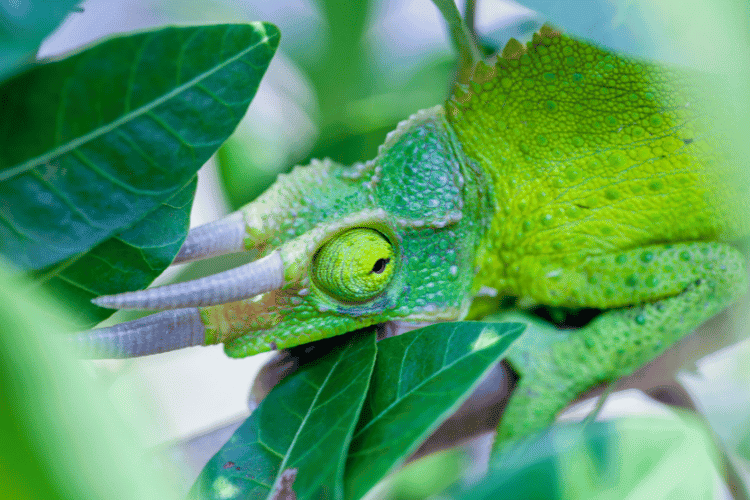
In some countries, including the United States, Jackson’s chameleons may be subject to federal regulations aimed at protecting their conservation status and regulating the exotic pet trade.
You may need a permit to own a Jackson’s chameleon as a pet, typically obtained through programs like the Convention on International Trade in Endangered Species (CITES).
Further, some states may prohibit the ownership of certain species, while others may have specific requirements or restrictions.
In Hawaii, for instance, Jackson’s chameleons are considered invasive species. Strict regulations are in place to prevent their spread, and it is illegal to release them into the wild.
Additional Resources
- Books:
- “Chameleons: Care and Breeding of Jackson’s, Panther, Veiled, and Parson’s” by Gary Ferguson, Kenneth Kalisch, Sean McKeown
- “Chameleon Care: The Complete Guide to Caring for and Keeping Chameleons as Pets” by Pet Care Professionals
- Forums:
- OurReptileForum.com
- Chameleonforums.com
Case Study
Watch Espio and his owner @nickdavis.00 interact with his captive habitat! He shows off his three magnificent horns effortlessly, making anyone fall in love with this unique species.
FAQs
Are Jackson’s chameleons friendly?
While they are not considered “friendly” in the same way as dogs or cats, some individuals can become tolerant of human presence with minimal handling, especially as they age.
However, they are naturally shy and may exhibit defensive behaviors when stressed.
Why do Jackson’s chameleons have horns?
The distinctive horns on the heads of male chameleons of this species serve several purposes. They are used in territorial displays and mating rituals.
During these displays, males may raise their forelegs and inflate their throat, showcasing their horns to intimidate rivals and attract females.

